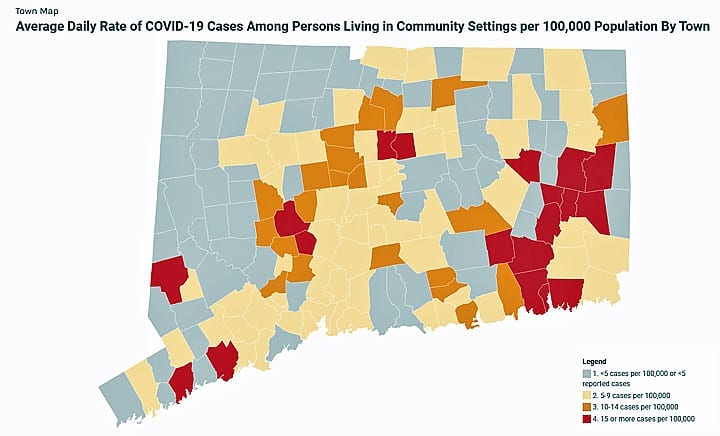COVID Hospitalizations Rising, But Not Close to Peak

Audio By Carbonatix

West Hartford had eight additional cases of COVID-19 according to data reported by the state on Thursday.
By Hugh McQuaid, CTNewsJunkie.com
With COVID-19 hospitalizations climbing and the number of towns in the “red alert” zone now at 19, Connecticut officials said Thursday the state maintains a more than adequate capacity of available beds at its hospitals.
Gov. Ned Lamont updated the state’s COVID-19 statistics during a press conference Thursday afternoon. Connecticut’s new infection rate remains elevated. Just over 500 residents tested positive since Wednesday. At 2.3%, the rate is higher than the 1% range the state saw for much of the summer, but it is down from Tuesday when the rate hit 3%.
The seven-day rolling average is currently 2.1%, Chief Operating Officer Josh Geballe said.

Lamont presented other concerning statistics: two more residents died of the virus and the number of towns in the state’s new “red alert” range – defined as having more than 15 positive cases per 100,000 residents – climbed from 11 last week to 19 this week.
Much of the briefing centered on the climbing number of Connecticut residents who have been hospitalized as a result of the coronavirus. Nineteen additional people were admitted to hospitals since Wednesday, bringing the state total to 232. Just a month ago, there were only 70 people hospitalized.
Although this month’s spike has been concerning, officials noted the state is still a far cry from the height of the early pandemic.
“As you remember in the bad-old-days, we had 2,000 COVID-related folks in our hospital rooms and they were staying there a longer period of time. Today we’re a little over 200. So we have a lot more capacity than we did before. People are spending a little less time in the hospital, a little less likely to go to the ICU,” Lamont said.
People who are hospitalized for the virus are having better outcomes than they were earlier in the crisis, the governor said. Six months ago, around one-third of hospitalized patients eventually required stays in intensive care. That number has dropped to around 20%, Lamont said. Meanwhile, in the early days, 22% of those requiring intensive care eventually died, he said. Now only 6% of ICU patients are dying, he said.
“They’re making incredible progress when it comes to keeping people alive and keeping people out of the ICU,” he said.
Geballe said currently a quarter of the state’s hospital beds are not being utilized and half of the available ICU beds are being used. Of the roughly 1,000 ICU beds in the state, Geballe said only 39 contain patients suffering from COVID-19.
“Although the trend on hospitalizations has been increasing, and we’ve been watching that very carefully, as a percentage of our total hospital capacity, the number of COVID hospitalizations we have is still very low,” Geballe said.
Acting Public Health Commissioner Deidre Gifford said the current level of overall hospitalization may even be slightly lower than usual for this time of year as some residents continue to put off elective procedures due to virus concerns.
Even if the situation worsened, the state is well-positioned to make additional hospital beds available if needed, they said.
During the height of the pandemic, Gifford said the state stood up COVID recovery facilities to help free up hospital beds by discharging virus patients to the recovery facilities when they still required some care but no longer needed hospitalization. Those facilities are still available if they’re needed, she said.
Hospitals also worked well together during the worst of the pandemic, Geballe said. Those relationships enable health care institutions to transfer patients, staff and resources around if one part of the health care system becomes overwhelmed, he said.
They can “load balance essentially,” he said. “We’re a small enough state where we can have that flexibility. That means that even if one particular county was experiencing a surge in their hospitals we could leverage the capacity we have in other counties.”
Republished with permission from CTNewsJunkie.com, all rights reserved.
Like what you see here? Click here to subscribe to We-Ha’s newsletter so you’ll always be in the know about what’s happening in West Hartford! Click the blue button below to become a supporter of We-Ha.com and our efforts to continue producing quality journalism.



